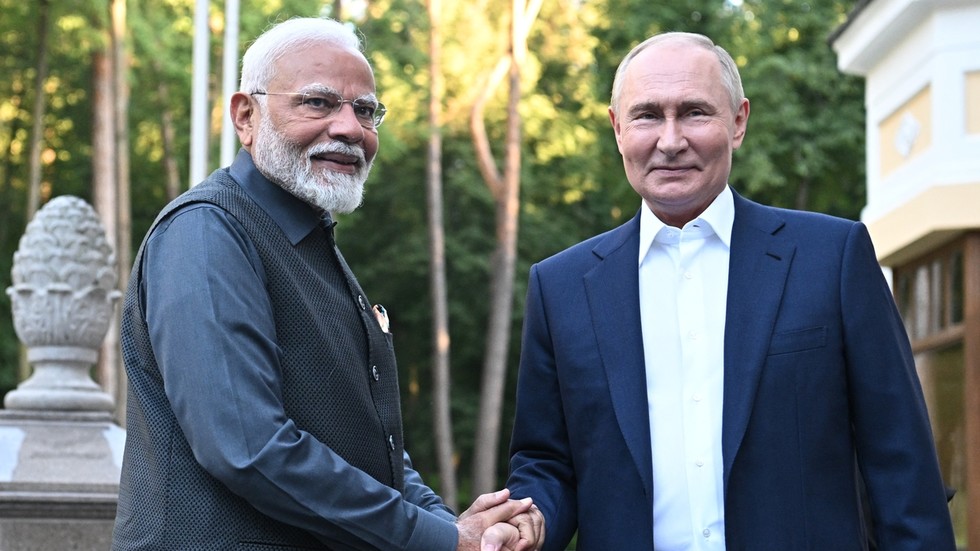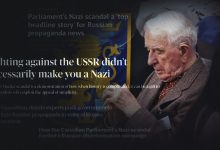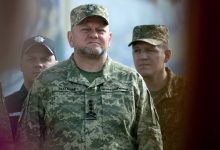
All is well in India-Russia ties. Diplomacy succeeded on both sides in finding common language on some sensitive issues in the final communique – with the West, no doubt, disappointed by its blandness
By Kanwal Sibal, retired Indian foreign secretary and former Ambassador to Russia between 2004 and 2007. He also held ambassadorial positions in Turkey, Egypt, France and was Deputy Chief of Mission in Washington DC.
By Kanwal Sibal, retired Indian foreign secretary and former Ambassador to Russia between 2004 and 2007. He also held ambassadorial positions in Turkey, Egypt, France and was Deputy Chief of Mission in Washington DC.
Russia’s President Vladimir Putin welcomes Indian Prime Minister Narendra Modi for an informal meeting at the Novo-Ogaryovo state residence, outside Moscow, on July 8, 2024. © Sergei BOBYLYOV / POOL / AFP
Prime Minister Narendra Modi’s visit to Russia was not intended to produce spectacular results. This is largely because the visit took place within days of the conclusion of the general election in India, followed by Modi’s swearing-in for his new term, his preoccupation with forming a new government, and acrimonious debates in Parliament. Modi made a foray to the G7 summit in Italy almost immediately after assuming office for a third consecutive term. There would not have been enough time for intensive work beforehand to finalize major new outcomes.
Nevertheless, the two sides signed nine agreements on cooperation apart from the joint statement.
The intention of the bilateral summit was to take stock of ties and offer solutions for how to give them more impetus, as well as discuss how to overcome the hurdles that have arisen because of the draconian sanctions placed on Russia, particularly on the financial front. Another pressing matter was how to consolidate the recent gains in bilateral trade while addressing the issue of the highly skewed trade balance against India.
Exchanging views on the agenda of the BRICS summit that Russia will be chairing later this year was also important.
Putin’s perspective on ending the conflict in Ukraine that is pitting Russia against the US and G7 as whole and has resuscitated Cold War-type tensions and adversely affected the Global South was of great interest to Modi.
Sending a strong message
The main outcome of the visit is the visit itself – Russia being chosen as the destination for Modi’s first bilateral venture abroad so soon after his re-election. This sent a strong signal to Russia of the importance India attaches to its ties with Russia. It was also a message to the West that New Delhi will not yield to undue pressure to dilute its ties with Moscow.
Read more
The visit provided a much needed opportunity to have an in-depth discussion personally with Putin. The format of the summit provided for extensive one-to-one talks between the leaders without aides. As it happened, the talks over dinner at Putin’s private residence lasted four and a half hours and the one-to-one talks two and a half hours.
Some Western foreign policy experts have expressed outrage on social media at Modi embracing Putin as well as the timing of the bilateral summit coinciding with the NATO summit in Washington D.C. , while the visit has also elicited some official comments from the US.
The State Department together with White House spokespeople have commented that the US has a full and frank dialogue with India, including about its relationship with Russia, and that it is critical for all countries, including India, to support efforts to realize a just and lasting peace in Ukraine.
The State Department spokesperson also said hours before the summit concluded that the US has had conversations with India in “the past 24 hours” on Modi’s visit. The White House spokesperson added that India’s longstanding relationship with Russia gives it the ability to urge Putin to end his “brutal and unprovoked war.“ On the whole, these remarks are not new and New Delhi can live with them – but it is objectionable that Washington claims the right to interfere in India-Russia ties.
President Zelensky’s outburst, however, chiding Modi as the leader of the world’s largest democracy hugging a “bloody criminal” in Moscow and inflicting a “devastating blow to peace efforts,” is contemptible. He should have kept in mind that Modi embraced him at the G7 summit although his democratic credentials and those of Ukraine itself are highly suspect, and Russia views him in the very terms in which he described Putin.
Focus on economic cooperation
The joint statement issued by the countries at the conclusion of the summit lists a compendium of efforts that both sides will make to bolster economic ties and remove impediments.
Read more
The need is recognized to actively explore new avenues for cooperation to forge a contemporary, balanced, mutually beneficial, sustainable and long-term partnership while further strengthening cooperation in the traditional areas.
In 2023, Indian and Russia achieved double the trade that they had planned by 2025 – reaching $65 billion versus the $30 billion target set earlier. But for balance and sustainability in the long term the sides stressed the need to increase Indian exports to Russia. A new bilateral trade target of $100 billion by 2030 has been set.
A joint statement on the development of strategic areas of Russia-India economic cooperation for the period up to 2030 was signed during the visit and nine key areas have been identified for action. These include cooperation in the development and supply of medicines and advanced medical equipment, as well as the possibility of opening branches of Indian medical institutions in Russia and recruiting qualified medical personnel.
Given that the issue of payments has been complicated by sanctions, both sides agreed to promote a bilateral settlement system using national currencies. Consultations about interoperability of the two countries’ respective financial messaging systems will continue.
The initial meeting in March 2024 to commence full negotiations for a Free Trade Agreement (on goods between India and the Eurasian Economic Union (EEU) was noted. The possibility of commencing negotiations for a bilateral free-trade agreement in services and investments was also mentioned.
It has been agreed to continue cooperation on the sustainable supply of fertilizers to India based on long-term contracts. On the energy side, it was agreed to explore new long-term contracts, including the possibility of further increasing supply of coking coal to India.
A Migration and Mobility Partnership Agreement between the two governments was also tabled.
To build new architecture for stable and efficient transport corridors, implementation of the Chennai-Vladivostok (Eastern Maritime) Corridor and the International North-South Transport Corridor, as well as use of the potential of the Northern Sea Route (for which a joint working body within the IRIGC-TEC for cooperation on the Northern Sea Route would be set up) are on the agenda.
Read more
A program of India-Russia cooperation in trade, economic, and investment spheres in the Russian Far East for the period from 2024-2029, especially in the sectors of agriculture, energy, mining, manpower, diamonds, pharmaceuticals and etc. has been signed.
On nuclear cooperation, on-schedule completion of the Kudankulam nuclear power plant which Russia is building in India and continuing discussions on the second site, including technical discussions on the VVER 1200 of Russian design, figured in the joint statement but no new initiatives were mentioned. In the realm of space, the countries will explore avenues for mutually beneficial cooperation in rocket engine development, production and use.
In terms of defense, importantly, both sides have agreed to encourage joint manufacturing in India of spare parts, components, aggregates, and other products for maintenance of Russian-origin arms and defense equipment under the ‘Make in India’ program. The joint statement specifically notes that this will be done through the transfer of technology and setting up of joint ventures. This is crucial both for meeting the needs of the Indian Armed Forces, as well as subsequent export to mutually friendly third countries with the approval of both sides.
Diplomacy at work
The emphasis on multipolarity is muted in the joint statement. India holding Voice of Global South virtual summits under its presidency in 2023 is seen as an important signal in favor of building a multipolar world order. The second reference to multipolarity is in the context of the increased role of the Shanghai Cooperation Organization (SCO) in the formation of a sustainable and multipolar world order.
Read more
On BRICS, Russia and India have agreed to continue joint efforts aimed at developing modalities for establishing a BRICS Partner Country Model, but the joint statement includes no reference to a further expansion of BRICS.
The language on terrorism is robust and meets India’s needs. Significantly, the two sides strongly condemned the “recent dastardly terrorist attack on an Army convoy in Kathua area of Jammu and Kashmir on 8th July 2024.”
The two sides noted with appreciation the close coordination between India and Russia on Afghanistan including through the dialogue mechanism between the Security Councils of both countries.
On the Ukraine conflict, the sides highlighted the imperative of reaching a peaceful resolution through dialogue and diplomacy including engagement between both parties. They noted with appreciation relevant proposals of mediation and good offices aimed at a peaceful resolution of the conflict in accordance with international law and on the basis of the UN Charter. Diplomacy worked well on both sides in finding common language on this very sensitive issue, with the West eyeing closely this part of the joint statement, and no doubt disappointed by its blandness.
In what is a deft diplomatic formulation, both sides agreed to strengthen joint efforts to build an architecture of equal and indivisible regional security and to intensify consultations on synergies between integration and development initiatives in Greater Eurasian space and in the regions of Indian and Pacific oceans. This takes care of Russia’s quest for equal and indivisible security in Europe and is balanced by India’s concerns in the Indo-Pacific area on which Russia’s approach is different.
In his address to the Indian community Modi said that a decision to open two new consulates in Kazan and Ekaterinburg had been taken, although this does not figure in the joint statement. All in all, the Modi-Putin summit has served the interests of both sides bilaterally, regionally and internationally.
The statements, views and opinions expressed in this column are solely those of the author and do not necessarily represent those of RT.



